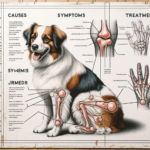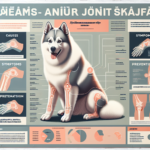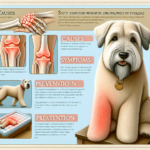Kooikerhondje Joint Pain: Causes, Symptoms, Prevention, and Treatment

Introduction
The Kooikerhondje, also known as the Dutch Decoy Dog, is a small to medium-sized breed that originated in the Netherlands. This breed was historically used for duck hunting, specifically to lure ducks into traps, a practice known as “kooien.” The Kooikerhondje is known for its distinctive orange-red and white coat, feathered tail, and expressive eyes. They are intelligent, agile, and affectionate dogs, making them excellent companions and versatile working dogs.
Like many breeds, the Kooikerhondje is prone to certain health issues, including joint pain. Joint health is particularly crucial for this breed due to their active nature and historical role in hunting. Ensuring the well-being of their joints can significantly impact their quality of life and longevity.
Breed-Specific Joint Pain Risks
Genetic Predisposition
The Kooikerhondje has a genetic predisposition to several joint-related issues, including hip dysplasia, elbow dysplasia, and arthritis. Hip dysplasia is a condition where the hip joint does not fit properly into the hip socket, leading to pain and mobility issues. Elbow dysplasia involves abnormal development of the elbow joint, causing lameness and discomfort. Arthritis, a degenerative joint disease, can also affect Kooikerhondjes, leading to chronic pain and stiffness.
Age-Related Risks
As Kooikerhondjes age, the risk of developing joint pain increases. While younger dogs may show early signs of joint issues, it is more common for symptoms to become apparent in middle-aged to senior dogs. Owners should be vigilant about monitoring their dogs for signs of joint pain as they reach these age milestones.
Activity Level and Joint Stress
The Kooikerhondje is an active and energetic breed, often participating in activities such as agility, obedience, and hunting. While regular exercise is essential for their overall health, high-impact activities can put stress on their joints. Owners should balance their dog’s activity level to prevent overexertion and potential joint damage.
Common Symptoms of Joint Pain in Kooikerhondje
General Symptoms
- Limping or favoring one leg
- Stiffness, especially after rest or exercise
- Reluctance to jump, run, or climb stairs
- Decreased activity or playfulness
- Swelling around the joints
- Whining or showing signs of discomfort when touched
Breed-Specific Symptoms
In Kooikerhondjes, joint pain may manifest as a reluctance to perform tasks they previously enjoyed, such as hunting or agility exercises. They may also show a noticeable change in their gait or posture, often trying to avoid putting weight on the affected joints.
When to Consult a Vet
If you notice any of the above symptoms in your Kooikerhondje, it is essential to consult a veterinarian promptly. Early diagnosis and intervention can help manage joint pain more effectively and improve your dog’s quality of life.
Preventive Measures for Joint Health
Exercise Recommendations
Regular, low-impact exercise is crucial for maintaining joint health in Kooikerhondjes. Activities such as swimming, walking, and controlled play can help keep their joints flexible and muscles strong without causing excessive stress. Avoid high-impact activities like jumping or running on hard surfaces, which can exacerbate joint issues.
Dietary Suggestions
A balanced diet rich in essential nutrients can support joint health. Consider incorporating foods or supplements that contain glucosamine, chondroitin, and omega-3 fatty acids, which are known to promote joint health and reduce inflammation. Consult your veterinarian for specific dietary recommendations tailored to your dog’s needs.
Weight Management
Maintaining a healthy weight is vital for reducing joint stress in Kooikerhondjes. Excess weight can put additional pressure on the joints, leading to pain and mobility issues. Monitor your dog’s weight regularly and adjust their diet and exercise routine as needed to keep them at an optimal weight.
Early Screening and Monitoring
Regular veterinary check-ups and early screening for joint issues can help catch problems before they become severe. Your veterinarian may recommend specific tests, such as X-rays or joint fluid analysis, to assess your dog’s joint health. Early intervention can significantly improve outcomes for dogs with joint pain.
Treatment Options for Joint Pain
Non-Surgical Treatments
Non-surgical treatments for joint pain in Kooikerhondjes include medications, physical therapy, and lifestyle adjustments. Anti-inflammatory drugs and pain relievers can help manage symptoms, while physical therapy can improve mobility and strengthen muscles around the joints. Lifestyle adjustments, such as providing a comfortable bed and avoiding high-impact activities, can also alleviate joint pain.
Surgical Options
In severe cases, surgical intervention may be necessary to address joint pain. Common surgical options include hip replacement, arthroscopy, and joint fusion. These procedures can help restore function and reduce pain, but they come with risks and require a significant recovery period. Consult your veterinarian to determine the best course of action for your dog.
Alternative Therapies
Alternative treatments such as acupuncture, hydrotherapy, and massage can also benefit Kooikerhondjes with joint pain. Acupuncture can help reduce pain and inflammation, while hydrotherapy provides low-impact exercise that supports joint health. Massage can improve circulation and relieve muscle tension around the joints.
Lifestyle and Management Tips
Daily Care Routine
A consistent daily care routine can help manage joint pain in Kooikerhondjes. This routine might include gentle exercise, administering medications or supplements, and providing a comfortable resting area. Regular check-ups with your veterinarian are also essential to monitor your dog’s condition and adjust their care plan as needed.
Modifying the Home Environment
Making your home more comfortable for a dog with joint pain can significantly improve their quality of life. Consider adding ramps to help them navigate stairs, providing orthopedic beds for better support, and placing non-slip mats on slippery surfaces to prevent falls.
Long-Term Management
Long-term management of joint pain involves a combination of regular veterinary care, appropriate exercise, a balanced diet, and a supportive home environment. By taking a proactive approach to joint health, you can help your Kooikerhondje stay active and happy despite joint pain.
FAQs About Kooikerhondje and Joint Pain
What are the early signs of joint pain in Kooikerhondjes?
Early signs of joint pain include limping, stiffness, reluctance to move, and decreased activity levels. If you notice any of these symptoms, consult your veterinarian for an evaluation.
Can joint pain in Kooikerhondjes be prevented?
While it may not be possible to prevent joint pain entirely, you can take steps to reduce the risk. These include maintaining a healthy weight, providing regular low-impact exercise, and ensuring a balanced diet with joint-supporting nutrients.
Are there specific exercises that are better for Kooikerhondjes with joint pain?
Yes, low-impact exercises such as swimming and walking are ideal for Kooikerhondjes with joint pain. These activities help maintain joint flexibility and muscle strength without causing excessive stress on the joints.
What dietary supplements can help with joint pain in Kooikerhondjes?
Supplements containing glucosamine, chondroitin, and omega-3 fatty acids can support joint health and reduce inflammation. Always consult your veterinarian before adding supplements to your dog’s diet.
When should I consider surgery for my Kooikerhondje’s joint pain?
Surgery may be considered if non-surgical treatments are ineffective and your dog is experiencing severe pain or mobility issues. Your veterinarian can help determine if surgery is the best option for your dog’s specific condition.
Conclusion
Joint pain is a common concern for Kooikerhondjes, but with proper care and attention, you can help manage and alleviate their discomfort. By understanding the causes, symptoms, and preventive measures, you can take proactive steps to support your dog’s joint health. Regular veterinary check-ups, a balanced diet, appropriate exercise, and a supportive home environment are all essential components of a comprehensive joint care plan. By prioritizing your Kooikerhondje’s joint health, you can ensure they lead a happy, active, and pain-free life.



